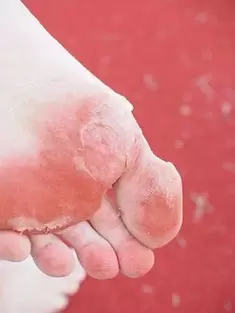Foot mycosis is the most common fungal infection of the skin at present. There are three main types of foot mycosis, or fungus on the feet, as it is also mentioned. And each type is localized on a different part of the foot and looks different.

How can you get foot fungus?
Foot mycosis is caused by a fungus that grows in or on the top layer of the skin. The fungus grows well in hot and humid locations. For example - in the area between the toes. Foot fungus spreads very easily. Enough of touching the fingers or toes of an infected person to also get sick with a high probability. But often, fungal infections occur when people walk barefoot on contaminated surfaces near swimming pools or in swimming pools, gyms and other similar objects. Fungus can then be in your shoes, especially if the shoes are very narrow and air cannot circulate around your feet.
If you touch an object that contains a fungus, after that you can also become a distributor of it and infect others. Moreover, even if you infect others, this does not mean that you yourself will be infected. Doctors don’t know why this happens, but everyone’s susceptibility to infection with fungus on their feet is different. And if you already have mycosis, there is a good chance of getting infected again.
2. Fungal symptoms
Symptoms of foot mycosis can be burning and itching of the skin between the toes. Skin can peel and crack. Other symptoms of foot fungus may vary depending on the type of athlete’s foot being diagnosed.
The first type is the infection that most often causes symptoms between the fourth and fifth toes. The skin becomes scaly, flaky and cracked. In some cases, a bacterial infection can accompany mycosis, and the skin condition worsens.
The second type of fungus is a disease that can start with mild pain in the foot area. Then the skin on the heel or bottom of the foot thickens and may crack. As the fungus on the feet grows, it also affects the nails. With nail fungus, it can thicken, break, or fall off. Fungal infections of the nails and skin of the feet should be treated differently, as a rule.
Vesicular infections are the third type of athlete’s foot. Usually, this type of foot fungus starts with blisters filled with fluid under the skin. Bubbles usually form on the bottom of the foot, but they can be found elsewhere on the foot. Equivalent bacterial infections can also develop with this type of foot fungus.
3. Diagnosis of mycosis
To diagnose foot fungus, the doctor, as a rule, only needs to examine the patient and review the medical history (symptoms, previous illness). If the fungus on your feet is unusual or does not respond to treatment, your doctor may take a sample of your skin or nails to test for the fungus.
Not all foot skin problems are mycosis, or foot fungus. If you suspect that you have fungus, but have never had it before, it actually makes sense to see a good dermatologist.
4. Treatment of diseases
To treat foot fungus, a special lotion, cream, or spray is usually sufficient. In severe cases, your doctor may prescribe prescription pills or topical medications to treat toenail fungus. It needs to be treated for the fungus as the doctor says. This will be a guarantee that it is really possible to cure the fungus completely. In addition to the treatment of foot mycosis in general, the feet are very clean and dry. The fungus needs a warm, moist place to grow.
To prevent mycosis and the reappearance of foot fungus, you should use your own special shoes when you go to the gym, swimming pool and similar places. To keep your feet dry, you can use talcum powder or special products. Sandals or shoes that are not too tight will provide adequate air circulation and moisture.
























